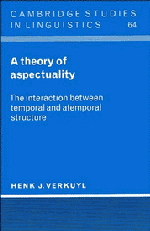PART I - ISSUES OF COMPOSITIONALITY
Published online by Cambridge University Press: 05 July 2011
Summary
INTRODUCTION TO PART I
The aim of this book is to present a theory about aspectual properties of sentences in natural language. These are properties allowing sentences to express temporal structure with respect to which they are interpreted. Sentences may pertain to states or processes or events, they may express boundedness, duration, repetition, semelfactivity, frequency, habituality, and many other forms of temporality. The question put in its simplest and crudest form is: how do they do this? The answer to this question will be given in terms of the opposition between terminative aspect (roughly, the expression of boundedness) and durative aspect (roughly, the expression of unboundedness). More particularly, it will be given by presenting a theory about the way terminative aspect is compositionally formed on the basis of semantic information expressed by different syntactic elements, in particular the verb and its arguments. It will be argued that an aspectual theory is explanatorily adequate only if it treats the opposition between terminative and durative aspect structurally. The focus of the theory proposed in the present study will be on the interaction between the temporal and atemporal information contributed by constituents involved in aspect construal.
Part I is introductory in the sense that it will try to clarify crucial issues which are involved. In chapter 1, some preliminary notions will be explained, identifying step by step the scope of this study. The provisional picture emerging is that of a simple ‘aspectual feature algebra’.
Information
- Type
- Chapter
- Information
- A Theory of AspectualityThe Interaction between Temporal and Atemporal Structure, pp. 1 - 4Publisher: Cambridge University PressPrint publication year: 1993
